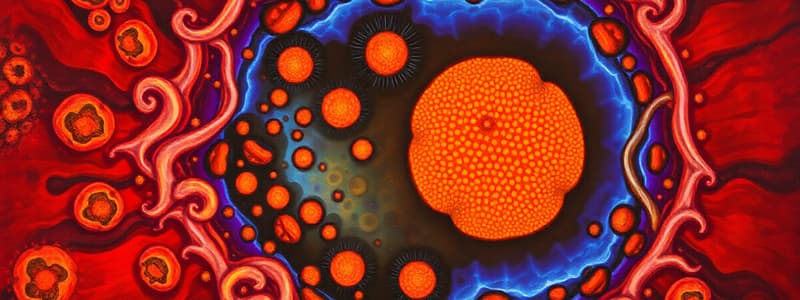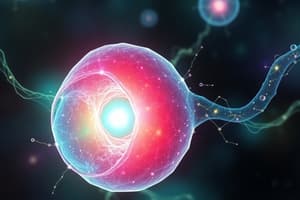Podcast
Questions and Answers
What is the effect of removing cytoplasm from an egg and leaving the nucleus intact?
What is the effect of removing cytoplasm from an egg and leaving the nucleus intact?
- Increased cell divisions and cell number.
- Delayed MBT with fewer cells than usual.
- Normal cleavage divisions with early MBT. (correct)
- No cleavage divisions occur.
How does injecting surplus non-frog DNA into an embryo affect the cell cycle?
How does injecting surplus non-frog DNA into an embryo affect the cell cycle?
- It slows down cleavage divisions and MBT occurs later.
- It completely inhibits cleavage divisions.
- MBT is triggered immediately after DNA injection.
- Cleavage divisions occur normally and MBT occurs earlier. (correct)
What triggers the mid-blastula transition (MBT) during embryonic development?
What triggers the mid-blastula transition (MBT) during embryonic development?
- Activation of histone acetyltransferases.
- A critical Nuclear/Cytoplasmic ratio. (correct)
- Depletion of histone stores.
- Increased levels of maternal mRNAs.
What role do cyclin-dependent kinases (Cdk) play in the cell cycle during embryonic development?
What role do cyclin-dependent kinases (Cdk) play in the cell cycle during embryonic development?
What is observed in haploid frog embryos during cleavage divisions?
What is observed in haploid frog embryos during cleavage divisions?
What is the central idea of Weismann's germ plasm theory?
What is the central idea of Weismann's germ plasm theory?
Which experimental observation contradicted Roux's conclusion about mosaic development in frogs?
Which experimental observation contradicted Roux's conclusion about mosaic development in frogs?
What does the term 'entelechy' refer to in Driesch's work on sea urchins?
What does the term 'entelechy' refer to in Driesch's work on sea urchins?
What distinguishes regulative development from mosaic development?
What distinguishes regulative development from mosaic development?
What characterizes the mid-blastula transition (MBT) in development?
What characterizes the mid-blastula transition (MBT) in development?
Which of the following factors is NOT suspected to control the timing of MBT?
Which of the following factors is NOT suspected to control the timing of MBT?
In which organism is the lineage restriction aspect of mosaic development prominently described?
In which organism is the lineage restriction aspect of mosaic development prominently described?
What process occurs during the late stages of the mid-blastula transition?
What process occurs during the late stages of the mid-blastula transition?
What is the primary result of the drop in cyclin levels by cycle 11?
What is the primary result of the drop in cyclin levels by cycle 11?
Which of the following best describes the fate of inner and outer cells after compaction in mammals?
Which of the following best describes the fate of inner and outer cells after compaction in mammals?
What characterizes the blastula stage in embryonic development?
What characterizes the blastula stage in embryonic development?
Which gene products are transcribed due to the extended gap in cell division after cyclin level decreases?
Which gene products are transcribed due to the extended gap in cell division after cyclin level decreases?
What initiates the compaction process in mammals?
What initiates the compaction process in mammals?
What is the primary consequence of cyclin levels dropping by cycle 11 in the cell cycle?
What is the primary consequence of cyclin levels dropping by cycle 11 in the cell cycle?
During compaction in mammals, what role does E-cadherin play?
During compaction in mammals, what role does E-cadherin play?
What is the significance of the different fates of inner and outer cells after compaction?
What is the significance of the different fates of inner and outer cells after compaction?
What occurs to cell divisions in an embryo when the cytoplasm is removed but the nucleus is left intact?
What occurs to cell divisions in an embryo when the cytoplasm is removed but the nucleus is left intact?
What characterizes the blastula stage in embryonic development?
What characterizes the blastula stage in embryonic development?
What is the result of injecting an excess of non-frog DNA into a frog embryo?
What is the result of injecting an excess of non-frog DNA into a frog embryo?
Which genes are transcribed due to the extended gap in cell division that occurs after cyclin level decreases?
Which genes are transcribed due to the extended gap in cell division that occurs after cyclin level decreases?
Which statement accurately describes the relation between nuclear/cytoplasmic ratio and mid-blastula transition (MBT)?
Which statement accurately describes the relation between nuclear/cytoplasmic ratio and mid-blastula transition (MBT)?
What primarily regulates the timing of cell cycle progression in early embryonic development?
What primarily regulates the timing of cell cycle progression in early embryonic development?
During which embryonic cell cycle stage does zygotic transcription get activated?
During which embryonic cell cycle stage does zygotic transcription get activated?
What does Weismann's germ plasm theory suggest about cleavage in developing embryos?
What does Weismann's germ plasm theory suggest about cleavage in developing embryos?
Which conclusion about sea urchin cleavage was drawn from Driesch’s experiments?
Which conclusion about sea urchin cleavage was drawn from Driesch’s experiments?
What distinguishes the mid-blastula transition from earlier cleavage divisions?
What distinguishes the mid-blastula transition from earlier cleavage divisions?
How might the observed discrepancies between sea urchins and frogs relate to the nature of their development?
How might the observed discrepancies between sea urchins and frogs relate to the nature of their development?
Which feature primarily signifies the transition from maternal to zygotic control during development?
Which feature primarily signifies the transition from maternal to zygotic control during development?
Which of the following most accurately describes mosaic development in C.elegans?
Which of the following most accurately describes mosaic development in C.elegans?
What is a common factor suspected to control the timing of MBT?
What is a common factor suspected to control the timing of MBT?
What happens to maternal mRNAs during late blastula stages?
What happens to maternal mRNAs during late blastula stages?
Study Notes
Weismann’s Theory and Germ Plasm
- Weismann transitioned from Lamarckian to Darwinist views in the 1880s.
- Known for germ plasm theory, describing how cleavage partitions distinct components into daughter cells.
Roux vs. Driesch on Development
- Roux claimed frog cleavage is strictly mosaic, but tying blastomeres still allowed normal development at half size.
- Driesch concluded sea urchin cleavage is regulative, suggesting a vital force, termed entelechy.
Discrepancy in Developmental Strategies
- Sea urchins and frogs may use different strategies for determining cell fate.
- Morgan's experiment replicated Driesch's on frogs, showing both blastomeres could develop into complete embryos.
Mosaic vs. Regulative Development
- Regulative development relies on cell-cell interactions, predominating in late cleavage divisions.
- Mosaic or determinative development restricts cell fate at each division, as seen in C.elegans.
- Most organisms exhibit a combination of both strategies.
Mid-Blastula Transition (MBT)
- MBT marks the shift from maternal to zygotic control of development, evident in large eggs from birds, fish, and amphibians.
- Early blastula features rapid cleavage divisions with no transcription, relying on maternal mRNAs.
- Late blastula shows slower division rates, gap phases (G1, G2), and zygotic transcription activation.
Mechanisms Controlling MBT
- MBT timing may be controlled by counting cleavage divisions or diminishing critical cytoplasmic/nuclear resources.
- Removal or addition of cytoplasm affects MBT timing; early MBT occurs in smaller eggs, while larger eggs experience delayed MBT.
Key Experiments
- Haploid frog embryos undergo normal cleavage and experience delayed MBT due to reduced DNA content.
- Non-frog DNA injection leads to early MBT, suggesting DNA quantity influences the timing of MBT.
Molecular Understanding of MBT
- Studies in Xenopus and Drosophila indicate that MBT is triggered when the nuclear/cytoplasmic ratio reaches a critical point.
- Drosophila MBT is well understood at the molecular level; the first 14 embryonic cycles are shared within a common cytoplasm.
Cellular Store Exhaustion
- Cell cycle progression relies on Cyclin-dependent kinases (Cdks), which activate when bound to cyclins that degrade after divisions.
- A drop in overall cyclin levels by cycle 11 results in cell cycle slowing, allowing for transcription of new genes including those for maternal mRNA degradation.
Compaction in Mammals
- Transition from blastula to morula in mammals features high E-cadherin expression, promoting tight cell association.
- Results in polarized cells, where inner cells contribute to the embryo and outer cells form the placenta.
Blastula Stage
- Known as blastoderm or blastocyst, this stage includes complete cleavage divisions prior to gastrulation.
- Produces an asymmetric embryo where cells in different locations have varied developmental fates.
- Formation of cavity (blastocoel) occurs, allowing for fluid-filled center creation.
Weismann’s Theory and Germ Plasm
- Weismann transitioned from Lamarckian to Darwinist views in the 1880s.
- Known for germ plasm theory, describing how cleavage partitions distinct components into daughter cells.
Roux vs. Driesch on Development
- Roux claimed frog cleavage is strictly mosaic, but tying blastomeres still allowed normal development at half size.
- Driesch concluded sea urchin cleavage is regulative, suggesting a vital force, termed entelechy.
Discrepancy in Developmental Strategies
- Sea urchins and frogs may use different strategies for determining cell fate.
- Morgan's experiment replicated Driesch's on frogs, showing both blastomeres could develop into complete embryos.
Mosaic vs. Regulative Development
- Regulative development relies on cell-cell interactions, predominating in late cleavage divisions.
- Mosaic or determinative development restricts cell fate at each division, as seen in C.elegans.
- Most organisms exhibit a combination of both strategies.
Mid-Blastula Transition (MBT)
- MBT marks the shift from maternal to zygotic control of development, evident in large eggs from birds, fish, and amphibians.
- Early blastula features rapid cleavage divisions with no transcription, relying on maternal mRNAs.
- Late blastula shows slower division rates, gap phases (G1, G2), and zygotic transcription activation.
Mechanisms Controlling MBT
- MBT timing may be controlled by counting cleavage divisions or diminishing critical cytoplasmic/nuclear resources.
- Removal or addition of cytoplasm affects MBT timing; early MBT occurs in smaller eggs, while larger eggs experience delayed MBT.
Key Experiments
- Haploid frog embryos undergo normal cleavage and experience delayed MBT due to reduced DNA content.
- Non-frog DNA injection leads to early MBT, suggesting DNA quantity influences the timing of MBT.
Molecular Understanding of MBT
- Studies in Xenopus and Drosophila indicate that MBT is triggered when the nuclear/cytoplasmic ratio reaches a critical point.
- Drosophila MBT is well understood at the molecular level; the first 14 embryonic cycles are shared within a common cytoplasm.
Cellular Store Exhaustion
- Cell cycle progression relies on Cyclin-dependent kinases (Cdks), which activate when bound to cyclins that degrade after divisions.
- A drop in overall cyclin levels by cycle 11 results in cell cycle slowing, allowing for transcription of new genes including those for maternal mRNA degradation.
Compaction in Mammals
- Transition from blastula to morula in mammals features high E-cadherin expression, promoting tight cell association.
- Results in polarized cells, where inner cells contribute to the embryo and outer cells form the placenta.
Blastula Stage
- Known as blastoderm or blastocyst, this stage includes complete cleavage divisions prior to gastrulation.
- Produces an asymmetric embryo where cells in different locations have varied developmental fates.
- Formation of cavity (blastocoel) occurs, allowing for fluid-filled center creation.
Studying That Suits You
Use AI to generate personalized quizzes and flashcards to suit your learning preferences.
Related Documents
Description
Explore key theories in developmental biology, focusing on Weismann's germ plasm theory and the contrasting strategies of Roux and Driesch in embryo development. Understand the differences between mosaic and regulative development and how these concepts are illustrated in various organisms.




